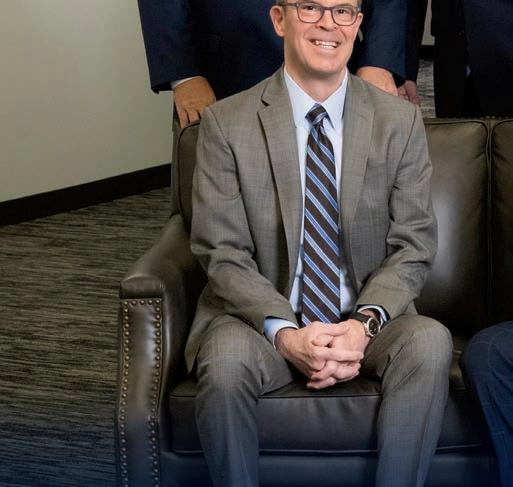
9 minute read
Cannabis-tracking mess demands a closer look
A“clerical error” that caused a dayslong re drill roiled the state’s edgling cannabis industry last week, and it bears a much closer look.
e state’s system for tracking cannabis from the time it’s still in the ground until consumers buy it is run by a Florida-based company called METRC LLC. is “seed-to-sale” tracking system is intended to make sure that all cannabis sold in the state has been grown, processed and sold by licensed companies and keep black-market weed out of the market.
Advertisement
Michigan regulators rely on this system when they need to enforce those laws.
But a notice from METRC to the state Cannabis Regulatory Agency that 85 percent of customers hadn’t paid a $40 monthly service fee bill and would be cut o from access to the system set o a wild scramble last week — and much confusion.
CRA regulators worked to alert companies on the list as delinquent on bills and eventually sent out a bulletin to all of them. ey then clogged phone lines to METRC customer service in an e ort to gure out the problem.
e real problem? Most of them weren’t delinquent at all.
e company later walked back the notice and said the gure was only 11 percent of customers who were more than three months past due on their bills. It blamed clerical er-
Michigan must choose: top-down or bottom-up
The choice between a top-down or bottom-up economic approach is becoming clear as Lansing politicians prepare for two important debates.
Legislative Democrats are considering a bill to repeal the state’s right-towork law, while also supporting plans backed by Gov. Gretchen Whitmer to use billions in state funds to subsidize a handful of rich corporations. One such plan, according to published reports, may add nearly $750 million in scal favors to a state incentive package for Ford Motor Co. and would raise the value of its incentive deal to nearly $1.8 billion. e verdict is in on such top-down economic development e orts. ey don’t work.
ror for the mixup.
CRA chief Brian Hanna blasted the company in an interview with Crain’s and called for it to sort out a billing system that cannabis companies have complained about.
“ e fact of the matter is we had multiple datasets from METRC that were apparently inaccurate,” Brian Hanna, executive director of the CRA, told Crain’s. “... e industry is going through hardships right now with the prices being so low, and they don’t need inaccurate data and poor communication from METRC.” at’s a big problem. e Mackinac Center studied a database of 2,300 Michigan-speci c subsidy deals across nine programs or program areas going back to 1983. e 2020 study compared companies and their performance with similar establishments that received no subsidies, tracking employment at each.
No cannabis can legally be sold in Michigan without being recorded in METRC. e reliability of its tracking system is critical to the legitimacy of an industry still trying to build credibility and that has consistently decried the e ect of black-market cannabis on a market where prices have crashed because of oversupply.
It’s still unclear exactly what went wrong in the data transmitted to the state. It is perfectly clear that it took too long to sort out the mistake before sending an entire industry into a panic that it would grind to a halt.
It might be easy to dismiss this as a simple error that was xed with no harm done. But because of the bigger issues surrounding the mistake and the importance of this tracking system, a closer look is needed.
Mistakes happen. But the integrity of the data in this system is important in ensuring integrity in an industry whose legitimacy depends on it.
Close scrutiny of what went wrong and what the CRA could have done di erently is in order. As is an examination by the state of the processes and the integrity of the METRC system.
Unfortunately, politicians and special interests have strong incentives to promote these counterproductive policies. Just don’t be fooled by promises that they will invigorate Michigan’s economy or arrest the exodus of Michigan residents.
As if o ering up $1.8 billion to just one company wasn’t bad enough, there is yet another plan to put $1.5 billion over the next few years into the state’s Strategic Outreach and Attraction Reserve fund. Lawmakers are heralding these subsidies as essential for the state to thrive, but the data tells a di erent story.
In ve of the nine state subsidy programs, there was no meaningful hiring di erence between subsidized and unsubsidized companies. In one, subsidized companies actually hired fewer net workers than their unsubsidized counterparts.
In the three that showed job creation, the cost per job created was stratospheric. e now-defunct Michigan Economic Growth Authority program o ered up to $125,000 per year per job. at’s not a sustainable way to build an economy, and it’s a slap in the face to unsubsidized employers.
Why do governments hand these subsidies out? Because they are powerful political tools for elected o cials who want to take credit for creating jobs. Governors are twice as likely to increase subsidy spending when they are running for reelection. Companies that make political donations are four times more likely to get subsidies than those that don’t. e same mechanism plays out in the Democratic leadership’s drive to repeal Michigan’s right-to-work law. Unlike many labor laws, right-to-work is not about the power balance between workers and employers. Rather, it’s about the relationship between union members and union bosses. e law prevents contracts that require employees to join and pay a union as a condition of working.
Just as corporate welfare deals are politics dressed up in rhetoric about job creation, the right-to-work repeal e ort dresses up in the rhetoric of worker’s rights. e description doesn’t agree with reality.
Two former United Auto Workers presidents pleaded guilty in 2020 to conspiring to steal more than $1 million in union funds. Members discovered union leadership had routinely been spending their dues on golf, swanky vacations, booze and other luxuries. More than a dozen top union o cials were found guilty on corruption charges. is is a textbook case of the rot that results when workers have no choice about union membership. But until federally mandated changes to the UAW’s election process, members had no direct say about who their leaders would be.
Right-to-work gives employees a choice in whether to support a union, creating a pro-worker environment in which union bosses are forced to pay more attention to the interests of members or risk losing them entirely. Some union leaders concede the benets of the law.
“ is is something I’ve never understood, that people think right-to-work hurts unions,” former UAW secretary-treasurer Gary Casteel told e Washington Post in 2014. “To me, it helps them. You don’t have to belong if you don’t want to. So if I go to an organizing drive, I can tell these workers, ‘If you don’t like this arrangement, you don’t have to belong.’” ere is clear economic power in freeing both workers and businesses from centralized, top-down control. e share of manufacturing employment in Michigan is 26 percent higher in a given county than it would be absent our right-to-work law. e history of Michigan is one of bottom-up success. e entrepreneurs who built the state were not seeking subsidies or following union dictates. ey invested in Michigan for what was then a positive business climate.
How our state’s elected o cials handle corporate subsidies and right-to-work in 2023 will tell us whether Michigan remains addicted to outdated top-down models or is ready to move toward a brighter, freer future.
Farmers
Access to capital
e West Michigan Young Farmers chapter, which has about seven members ages 35 and younger, launched the West Michigan Farmers of Color Land Fund about a year-and-a-half ago with a GoFundMe campaign. e group is raising $55,000 that will go toward securing land and infrastructure for people of color who want to farm in West Michigan.
e fundraiser was modeled after two successful e orts in southeast Michigan. e Detroit Black Farmer Land Fund, launched on Juneteenth in 2020, has funded 37 awardees who are now landowners, while e Washtenaw County Black Farmer Fund raised $100,000 in its rst round after launching a year ago.
Kelly describes the West Michigan fund as “a mutual aid framework” for farmers on the local level.
“(It will help) us to work with our community and nd creative, tangible solutions that are impactful — even though we know that federal policy change is going to be the thing that moves the needle the most,” she said. “But we can’t really wait for federal policy change to advocate and support our local BIPOC growers.”
One federal olive branch that has been extended: e USDA is working to establish an O ce of Urban Agriculture in Grand Rapids and another in Detroit. Kelly is hopeful the Grand Rapids branch will connect farmers with grants and loans to fund their ventures.
“ at’s something that we’ve needed desperately in this area,” she said.
Land hurdles
Although acquiring urban farmland is theoretically more a ordable than buying a large rural plot, city farming comes with plenty of hurdles. As chair of the Urban Agriculture Committee for the city of Grand Rapids until last December, Kelly saw the lack of available land rsthand.
At last count, she said there were only about 60 vacant plots in Grand Rapids, most of which are too small to scale an urban farm. Churches or developers own other green space in the city that might be ripe for agriculture, she said.
ere’s also tension between urban farmers and developers about the most appropriate use of vacant land, especially given Grand Rapids’ housing shortage. Kelly said the city of Grand Rapids has indicated it’s willing to allow urban farming on some vacant lots, but those wrinkles have yet to be ironed out.
Jenkins-Smith was ready to give up on urban farming altogether after turning over so many lots.
“(It) was OK, because I didn’t want to lock people into something that they didn’t believe in anymore, but it was disheartening,” she said. “I would have put in all of this input into the soil and used all these resources, manpower and everything to get it ready for production and then ... have someone change their mind the following season.”
She had decided to start shopping for rural land when she learned of USDA grant funding opportunities for urban agriculture. She’s currently exploring starting a packaged produce line or selling directly to house- holds instead of running a CSA. She also recently acquired 0.7 acres in the Comstock Park area of Plain eld Township for an urban farm, and hopes to buy more in Grand Rapids.

Alternatives for farmland
Liz Visser, a member of West Michigan Young Farmers, serves as farm manager for the Blandford Nature Center Farm in Grand Rapids. e nonpro t nature center’s farmland is on land cultivated under an agreement with the city of Grand Rapids.
Visser’s situation allows her to farm for Blandford without having to buy her own land. But that’s a rarity for most young farmers — “especially if you want to farm close to your community, and your community happens to be in an urban area,” she said.
Visser said her advocacy work is about pushing to preserve land for farming so it doesn’t all get swallowed up for building projects.
“ ere are midsize cities that have a di erent approach to urban agriculture, and I think it’s just about, where are the priorities?” she said.
“Right now, it seems like the priority is trying to get as much housing as possible (on) vacant lots in the city. And I want to be clear, I don’t think that’s a bad goal. … But something that I would love to see is if there was just a priority made on making some land accessible for if people wanted to grow on it in an urban area.”
The talent pipeline
West Michigan Young Farmers notes on its website that people of color are “drastically underrepresented” in farming in the U.S. About 1.4 percent of farmers nationally are Black, according to the most recent USDA Agricultural Census, and that percentage is lower in Michigan. e Blandford Nature Center Farm tries to hire as many young people as possible and allows them to explore a variety of interests within farming, like beekeeping, cut owers and sugar-sap collecting, as well as raising crops, Visser said. e nonpro t also routinely hosts young volunteers from schools and community groups. at same year, she and several community groups, including Visser at Blandford farm, won a grant from the USDA to launch the Freedom Farm Collective (now called Grow Collective). ere, they plan to provide mentoring for young growers at the elementary, middle and high school level, as well as an incubator for BIPOC growers, Kelly said.
Kelly and Visser believe that can change, not only through friendlier government policies, but by fostering interest in farming among young people.
Kelly in 2021 launched the Freedom School, a community garden behind the MLK Park Lodge in Grand Rapids where children learn how to grow and harvest food.
“We’re still at the beginning stages of really guring out what that looks like and how to get funding to get that o the ground … but that’s the direction that we would like to take things in the future,” Visser said.
Contact: rachel.watson@crain.com (989) 533-9685; @RachelWatson86
Working alongside our clients, our experienced team creates tailored solutions to meet their unique financing needs.

Our Commercial Banking team recently provided over $11 million in acquisition financing for a plastic injection molding company, including a working capital line of credit, an equipment term loan and full treasury management services. Thanks to the team’s expertise, the loan was able to be closed two weeks from engagement with Waterford Bank.


Let







